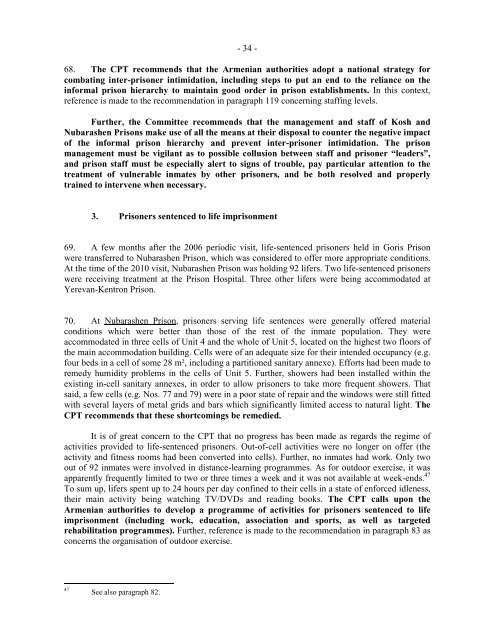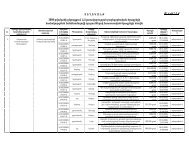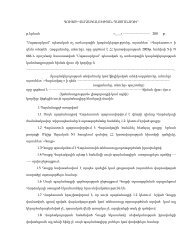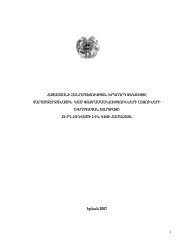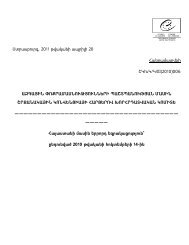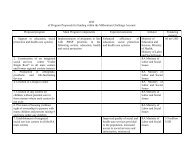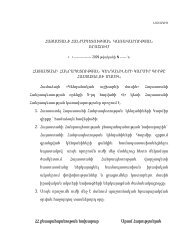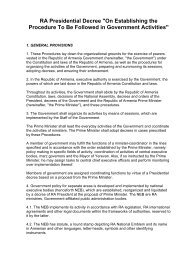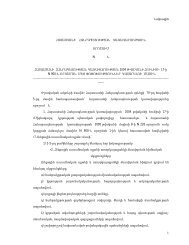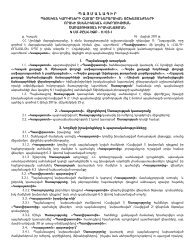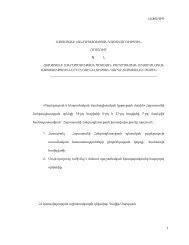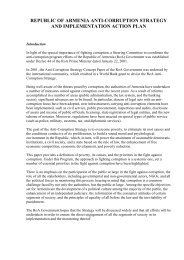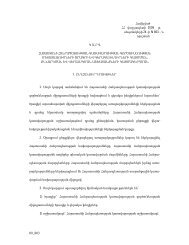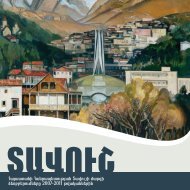- 34 -68. <strong>The</strong> <strong>CPT</strong> recommends that the <strong>Armenia</strong>n authorities adopt a national strategy forcombating inter-prisoner intimidation, including steps to put an end to the reliance on theinformal prison hierarchy to maintain good order in prison establishments. In this context,reference is made to the recommendation in paragraph 119 concerning staffing levels.Further, the Committee recommends that the management and staff of Kosh andNubarashen Prisons make use of all the means at their disposal to counter the negative impactof the informal prison hierarchy and prevent inter-prisoner intimidation. <strong>The</strong> prisonmanagement must be vigilant as to possible collusion between staff and prisoner “leaders”,and prison staff must be especially alert to signs of trouble, pay particular attention to thetreatment of vulnerable inmates by other prisoners, and be both resolved and properlytrained to intervene when necessary.3. Prisoners sentenced to life imprisonment69. A few months after the 2006 periodic visit, life-sentenced prisoners held in Goris Prisonwere transferred to Nubarashen Prison, which was considered to offer more appropriate conditions.At the time of the <strong>2010</strong> visit, Nubarashen Prison was holding 92 lifers. Two life-sentenced prisonerswere receiving treatment at the Prison Hospital. Three other lifers were being accommodated atYerevan-Kentron Prison.70. At Nubarashen Prison, prisoners serving life sentences were generally offered materialconditions which were better than those of the rest of the inmate population. <strong>The</strong>y wereaccommodated in three cells of Unit 4 and the whole of Unit 5, located on the highest two floors ofthe main accommodation building. Cells were of an adequate size for their intended occupancy (e.g.four beds in a cell of some 28 m², including a partitioned sanitary annexe). Efforts had been made toremedy humidity problems in the cells of Unit 5. Further, showers had been installed within theexisting in-cell sanitary annexes, in order to allow prisoners to take more frequent showers. Thatsaid, a few cells (e.g. Nos. 77 and 79) were in a poor state of repair and the windows were still fittedwith several layers of metal grids and bars which significantly limited access to natural light. <strong>The</strong><strong>CPT</strong> recommends that these shortcomings be remedied.It is of great concern to the <strong>CPT</strong> that no progress has been made as regards the regime ofactivities provided to life-sentenced prisoners. Out-of-cell activities were no longer on offer (theactivity and fitness rooms had been converted into cells). Further, no inmates had work. Only twoout of 92 inmates were involved in distance-learning programmes. As for outdoor exercise, it wasapparently frequently limited to two or three times a week and it was not available at week-ends. 47To sum up, lifers spent up to 24 hours per day confined to their cells in a state of enforced idleness,their main activity being watching TV/DVDs and reading books. <strong>The</strong> <strong>CPT</strong> calls upon the<strong>Armenia</strong>n authorities to develop a programme of activities for prisoners sentenced to lifeimprisonment (including work, education, association and sports, as well as targetedrehabilitation programmes). Further, reference is made to the recommendation in paragraph 83 asconcerns the organisation of outdoor exercise.47See also paragraph <strong>82</strong>.
- 35 -71. At Yerevan-Kentron Prison, the material conditions in which the three life-sentencedprisoners were accommodated give cause for serious concern. <strong>The</strong>ir cells were small, measuringjust over 6 m², and were too narrow (i.e. less than 2 m between the walls). Further, there waslimited access to natural light and no outside view (as the windows faced a wall). Cells Nos. 20 and21 were in a relatively good state of repair and hygiene, but cell No. 18 was filthy, infested withmice and the water tap was broken with water running continuously. At the end of the visit, thedelegation requested a report on steps taken to improve the material conditions of detention of theseinmates. In their responses of 6 and 9 September <strong>2010</strong>, the <strong>Armenia</strong>n authorities informed the <strong>CPT</strong>that measures were being taken (e.g. improvement of access to natural light, repair of the water tapand de-infestation of cell No. 18). However, the fundamental problem of the inadequate size of thecells remains. <strong>The</strong> <strong>CPT</strong> recommends that a solution be found without delay on this issue:either the cells are enlarged or, preferably, the three prisoners concerned are accommodatedelsewhere.<strong>The</strong> situation was aggravated by the regime of solitary confinement applied to the three lifesentencedprisoners. Two of them had been held in such conditions for over nine years. <strong>The</strong>y werenot allowed to associate with each other or with any other prisoner. <strong>The</strong>y did not even have a TV setor radio in their cells (unlike the third inmate). <strong>The</strong> only regular out-of-cell activity consisted ofdaily outdoor exercise, which was taken alone in a yard on the top floor of the prison building. Suchconditions could be considered as amounting to inhuman treatment and contributed to thedegradation in the prisoners’ mental health (see, in this respect, paragraph 110).<strong>The</strong> recommendation made in paragraph 70 applies equally to the three life-sentencedprisoners held at Yerevan-Kentron Prison. As regards more specifically the two life-sentencedprisoners who had been held in conditions of solitary confinement for years, immediate stepsmust be taken to allow them contact with other inmates. <strong>The</strong> Committee also wishes to receiveconfirmation that TV sets have been installed in the cells of these two prisoners. 4872. It appeared that measures had been taken after the 2006 visit to ensure that the handcuffingof prisoners sentenced to life imprisonment during out-of-cell movements was based on anindividual risk assessment. However, following the escape of two lifers from Nubarashen Prison inNovember 2009, the practice of systematic handcuffing of life-sentenced prisoners whenever theywere taken out of their cells had been re-introduced in that establishment; 49 in the <strong>CPT</strong>’s view, thisis disproportionate and could well be considered as a form of collective punishment. Further, liferswere apparently handcuffed during dental treatment and, on occasion, during phone calls.It is also of concern to the <strong>CPT</strong> that relations between life-sentenced prisoners and custodialstaff in the establishments visited were reduced to the strict minimum. In the opinion of theCommittee, much more emphasis must be placed on building positive relations between staff andthese inmates. This is in the interests not only of the humane treatment of the prisoners but also ofthe maintenance of effective control and security and of staff safety. 50484950In a communication of 9 September <strong>2010</strong>, the <strong>Armenia</strong>n authorities informed the Committee that these twoprisoners had been allowed to have a TV set.<strong>The</strong>re was no such practice at Yerevan-Kentron Prison.This is also one key element of the concept of “dynamic security”.
- Page 1 and 2: Strasbourg, 1 December 2010SecretCP
- Page 3 and 4: - 3 -D. Prison Service establishmen
- Page 5 and 6: - 5 -Copy of the letter transmittin
- Page 7 and 8: - 7 -B. Establishments visited3. Th
- Page 9 and 10: - 9 -6. As emphasised by the CPT in
- Page 11 and 12: - 11 -II.FACTS FOUND DURING THE VIS
- Page 13 and 14: - 13 -13. The case of Vahan KHALAFY
- Page 15 and 16: - 15 -In the CPT’s view, professi
- Page 17 and 18: - 17 -All these steps permitted the
- Page 19 and 20: - 19 -In order for the Committee to
- Page 21 and 22: - 21 -33. With respect to the right
- Page 23 and 24: - 23 -38. The CPT is pleased to not
- Page 25 and 26: - 25 -B. Military establishments1.
- Page 27 and 28: - 27 -The CPT trusts that the Armen
- Page 29 and 30: - 29 -55. In the light of the above
- Page 31 and 32: - 31 -D. Prison Service establishme
- Page 33: - 33 -65. In the establishments vis
- Page 37 and 38: - 37 -4. Foreign prisoners75. Durin
- Page 39 and 40: - 39 -83. In the CPT’s view, the
- Page 41 and 42: - 41 -Further, the Committee recomm
- Page 43 and 44: - 43 -6. Health carea. health-care
- Page 45 and 46: - 45 -107. The CPT wishes to recall
- Page 47 and 48: - 47 -e. Yerevan Prison Hospital’
- Page 49 and 50: - 49 -f. suicide prevention117. Sui
- Page 51 and 52: - 51 -121. The procedure contained
- Page 53 and 54: - 53 -126. Several remand prisoners
- Page 55 and 56: - 55 -133. The Secure Unit of Nubar
- Page 57 and 58: - 57 -The CPT recommends that the A
- Page 59 and 60: - 59 -6. Means of restraint144. For
- Page 61 and 62: - 61 -148. The delegation’s findi
- Page 63 and 64: - 63 -F. Social care homes1. Prelim
- Page 65 and 66: - 65 -159. Concerning food, the del
- Page 67 and 68: - 67 -The CPT recommends that the A
- Page 69 and 70: - 69 -APPENDIX ILIST OF THE CPT'S R
- Page 71 and 72: - 71 -Investigations into cases pos
- Page 73 and 74: - 73 -- verbal information on right
- Page 75 and 76: - 75 -- the Armenian authorities to
- Page 77 and 78: - 77 -comments- the CPT trusts that
- Page 79 and 80: - 79 -- appropriate steps to be tak
- Page 81 and 82: - 81 -Health carerecommendations- t
- Page 83 and 84: - 83 -comments- the CPT trusts that
- Page 85 and 86:
- 85 -requests for information- cla
- Page 87 and 88:
- 87 -- steps to be taken at both e
- Page 89 and 90:
- 89 -Social care homesIll-treatmen
- Page 91 and 92:
- 91 -comments- the Armenian author
- Page 93 and 94:
- 93 -B. OTHER AUTHORITIESProsecuto
- Page 95 and 96:
Instruction #Ց-2 dated 29.01.2009
- Page 97 and 98:
was brought in by the court of firs
- Page 99 and 100:
As a result of the facts of various
- Page 101 and 102:
The right of inerrogation of a witn
- Page 103 and 104:
The departmental network is being i
- Page 105 and 106:
Respective measures have been taken
- Page 107 and 108:
Review of criteria for serving the
- Page 109 and 110:
In cases of non-performance of the
- Page 111 and 112:
mentioned establishment does not pr
- Page 113 and 114:
The problem of overcrowding exists
- Page 115 and 116:
een taken by the Penitentiary Servi
- Page 117 and 118:
facilities, closed, semi-closed and
- Page 119 and 120:
causes certain difficulties in prov
- Page 121 and 122:
Medical units of penitentiary estab
- Page 123 and 124:
appropriate, sentenced prisoners ar
- Page 125 and 126:
Armenia; pursuant to the Decision o
- Page 127 and 128:
In connection with paragraph 122 of
- Page 129 and 130:
liable in the manner prescribed by
- Page 131 and 132:
esidents by the staff is punishable
- Page 133 and 134:
Order of the residents’ admission
- Page 135 and 136:
Termination of“Erebouni”functio
- Page 137 and 138:
հոդվածի համաձայն, ք
- Page 139 and 140:
Հասարակական կարգի
- Page 141 and 142:
ՀՀ ոստիկանության հ
- Page 143 and 144:
Ինչ վերաբերում է բե
- Page 145 and 146:
ՀՀ կառավարության 05.
- Page 147 and 148:
ոստիկանության անձն
- Page 149 and 150:
ՈՒսումնասիրելով այ
- Page 151 and 152:
դատապարտյալներ, ին
- Page 153 and 154:
Զեկույցի 69-րդ և 70-րդ
- Page 155 and 156:
տեսակցությունների
- Page 157 and 158:
Ինչ վերաբերվում է հ
- Page 159 and 160:
զբոսանքի կազմակերպ
- Page 161 and 162:
լոգանք ընդունելու
- Page 163 and 164:
ՀՀ ԱՆ ՔԿՎ բժշկական
- Page 165 and 166:
կանոնները, հիվանդն
- Page 167 and 168:
դատապարտյալը կատար
- Page 169 and 170:
ծառայության կալանա
- Page 171 and 172:
• ՀՀ ԱՆ հրավերով Ֆր
- Page 173 and 174:
Բնակելի մակերեսով
- Page 175 and 176:
Հարազատների հետ կա
- Page 177 and 178:
ՀՀարդարադատության
- Page 179 and 180:
ՙՎարդաշեն՚Գործուն


